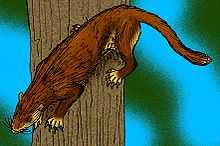Hyopsodontidae
| Hyopsodontidae Temporal range: Early Paleocene to Eocene | |
|---|---|
 | |
| A tube sheep | |
| Scientific classification | |
| Kingdom: | Animalia |
| Phylum: | Chordata |
| Class: | Mammalia |
| Order: | †Condylarthra |
| Family: | †Hyopsodontidae Trouessart, 1789 |
| Genera | |
|
see text | |
Hyopsodontidae is an extinct family of unspecialized, primitive mammals from the Condylarthra order, living from the Paleocene to the Eocene in North America and Eurasia. Condylarthra is now thought to be a wastebasket taxon and the hyopsodontids may be related to Afrotheria instead.[1]
They were generally small insectivorous animals. The most common genus is Hyopsodus.
All of them were small ungulates, their size ranging from that of a squirrel to that of a weasel. Although much more herbivorous in their diet than the arctocyonids, and lacking their powerful canines, the hyopsodontids still had a generalized dentition, with a full set of incisors, canines, premolars, and molars. During the Paleocene in Europe, they reached a high diversity level, starting with Louisina and Monshyus in Hainin and following in the Cernaysian beds with Tricuspiodon, Paratricuspiodon, and Paschatherium.[2]
List of genera
- Aletodon
- Dorraletes
- Haplaletes
- Haplomylus
- Hyopsodus
- Litomylus
- Microhyus
- Paratricuspiodon
- Paschatherium
- Phenacodaptes
- Tricuspiodon
References
- ↑ Rodolphe Tabuce et al. (2007) Early Tertiary mammals from North Africa reinforce the molecular Afrotheria clade. Proc. R. Soc. B 2007 274, doi:10.1098/rspb.2006.0229
- ↑ Agusti, Jordi; Anton, Mauricio (2002). Mammoths, Sabertooths, and Hominids: 65 Million Years of Mammalian Evolution in Europe. Columbia University Press. ISBN 0-231-11640-3..